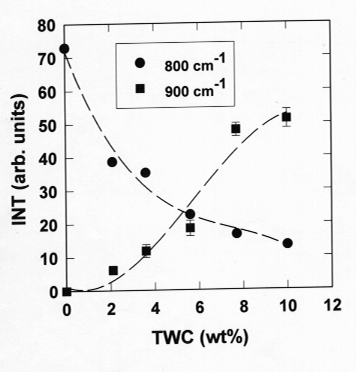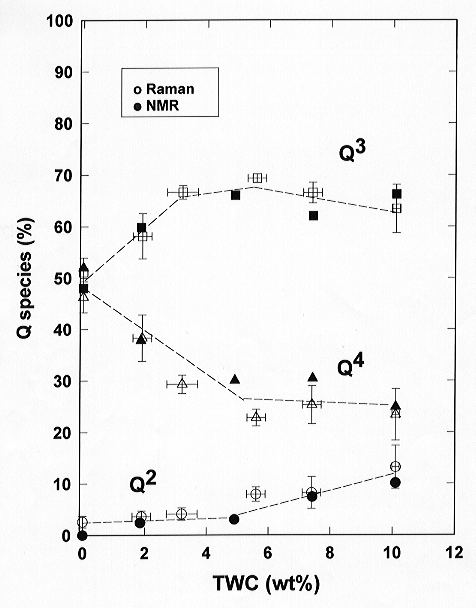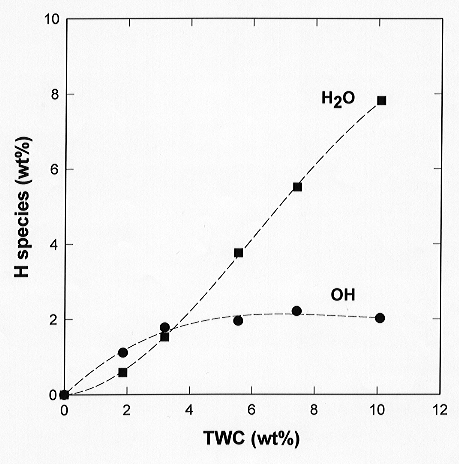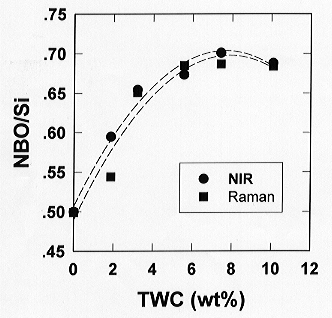

In order to resolve some of the controversies on the solubility mechanism of water in silicate melts, a program was started to study melts and glasses in a very simple model system (Na2Si4O9 - H2O) by a variety of spectroscopic and diffraction methods. These methods include neutron and X-ray diffraction, a variety of NMR experiments as well as Raman and infrared spectroscopy. By cross-checking the results from different methods, we want to establish a solid base for the interpretation and quantification of spectroscopic data that can later be used for understanding more complicated systems.
We have measured the Raman spectra of several protonated and deuterated sodium tetrasilicate glasses with 2, 3, 5, 7, and 10 wt% total water content (TWC) at room temperature and ambient pressure. These measurements will later be extended to high temperature and pressure. The experiments were performed in 155 degree scattering geometry with the 514.5 nm laser line of a coherent Ar+ laser and a SPEX 1877 triplemate spectrometer equipped with a Photometrics Ltd CCD camera detector. Each sample was measured in four overlapping spectral windows covering the spectral range from 150 to 1350 wavenumbers with accumulation times typically from 5 to 20 minutes per scan.
The presence of water leads to significant changes in the Raman spectra of the hydrous glasses. The integral intensity of the 800 cm-1 band, usually assigned to cage-like vibrations of three-dimensional network units, decreases with increasing TWC (Fig. 3.5-4). At the same time the integral intensity of the 900 cm-1 band, attributed to Si-OH stretching vibrations, increases almost linearly with increasing TWC up to about 6 wt% TWC after which it starts to saturate (Fig. 3.5-4). These data clearly show, in agreement with previous NMR and neutron diffraction studies, the presence of Si-OH groups which depolymerize the structure of the anhydrous sodium tetrasilicate glass. Further evidence in support of this conclusion is the observed isotopic shift of the 900 cm-1 band in deuterated and protonated samples.
Additional insight into the mechanism of depolymerization was obtained
by Gaussian decomposition of the high-frequency band centred at about 1100
cm-1 into four bands centered at about 956, 1050, 1090 and 1140
cm-1, commonly attributed to Q2 (956), Q3
(1050 + 1090), and Q4 (1140) units, respectively. The variation
of the Q-species with TWC obtained from the integral Raman intensities,
assuming equal scattering cross sections, is in excellent agreement with
previous NMR data (Fig. 3.5-5). Initially the Si-O network is depolymerized
due to Q4-O-Q4 bond breaking, while above 5-6 wt%
TWC the mechanism changes and the Q4-O-Q3 bond breaking
starts to dominate. The rate of depolymerization decreases above 5-6 wt%
TWC in agreement with the variation of the integral intensities of the
800 and 900 cm-1 bands.
 |
 |
Fig. 3.5-4: Intensity of the 800 (dots) and 900 cm-1 (squares) Raman bands in hydrous sodium tetrasilicate glasses. |
Fig. 3.5-5: Q-species distribution in hydrous sodium tetrasilicate glasses. |
To determine the concentrations of OH and molecular H2O in
the sodium tetrasilicate glasses, we measured near infrared spectra. Using
the conventional assumption that the combination band at 4500 cm-1
is due to Si-OH groups while the band at 5200 cm-1 is due to
molecular water, the results in Fig. 3.5-6 were obtained. From the
abundance of Si-OH groups determined by infrared spectroscopy one can calculate
the number of non-bridging-oxygens per Si atom (NBO/Si). This parameter
can also be calculated from the abundance of Q3-species as measured
in the Raman spectra. Figure 3.5-7 compares the results of these two calculations,
which again yield excellent agreement.
 |
 |
Fig. 3.5-6: Water speciation in hydrous sodium tetrasilicate glasses. |
Fig. 3.5-7: NBO/Si in hydrous sodium tetrasilicate glasses. |

Tel: +49-(0) 921 55 3700 / 3766, Fax: +49-(0) 921 55 3769, E-mail: bayerisches.geoinstitut(at)uni-bayreuth.de
 Previous page
Previous page